 Looking out the window yesterday, I was crushed by what I saw. Snow falling at a rapid rate. Nor did it quit-hours later there was still snow falling. Wouldn’t you think that after all the snow we have had in the past 5 days, that nature would be out of snow? Are not the snow reserves in the upper atmosphere completely depleted? Is nature not exhausted from her nation wide, days long snow and ice dump, and needing to scale back, or take a nap, or something? Is she not getting a little bored with all the white everywhere, and thinking to switch on some other type of weather? Change the channel, maybe? I have places where the 30 inch tall boxwood has a snow top hat over 36 inches tall. Yes, the snow came spectacularly wrapped in a wind package.
Looking out the window yesterday, I was crushed by what I saw. Snow falling at a rapid rate. Nor did it quit-hours later there was still snow falling. Wouldn’t you think that after all the snow we have had in the past 5 days, that nature would be out of snow? Are not the snow reserves in the upper atmosphere completely depleted? Is nature not exhausted from her nation wide, days long snow and ice dump, and needing to scale back, or take a nap, or something? Is she not getting a little bored with all the white everywhere, and thinking to switch on some other type of weather? Change the channel, maybe? I have places where the 30 inch tall boxwood has a snow top hat over 36 inches tall. Yes, the snow came spectacularly wrapped in a wind package.
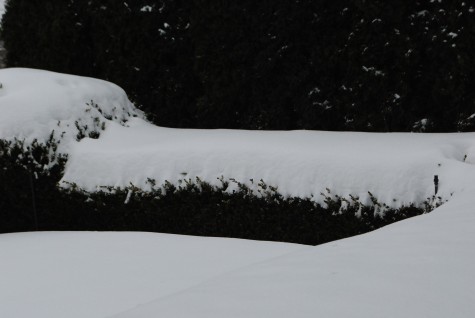 It’s not as though I have no tolerance for winter weather-after all, this is my 60th winter in this zone. But the volume of snow we have had has wrought a remarkable change in the landscape. That every crisp angle and shape is blurred-an ordinary consequence of the Michigan winter. But the volume of white in the landscape is making every other still struggling to survive color go black. I can always tell when the temperatures get very cold-my yews at home will go black green. Today they make a black hedge with a few white specks. Boxwood is a lighter green color-this boxwood has gone black from the sheer volume of white engulfing it. In spite of my exasperation with the current weather, I am noticing that the extreme contrast between black and white is painting a graphically stark and pared down picture of the design of the landscape.
It’s not as though I have no tolerance for winter weather-after all, this is my 60th winter in this zone. But the volume of snow we have had has wrought a remarkable change in the landscape. That every crisp angle and shape is blurred-an ordinary consequence of the Michigan winter. But the volume of white in the landscape is making every other still struggling to survive color go black. I can always tell when the temperatures get very cold-my yews at home will go black green. Today they make a black hedge with a few white specks. Boxwood is a lighter green color-this boxwood has gone black from the sheer volume of white engulfing it. In spite of my exasperation with the current weather, I am noticing that the extreme contrast between black and white is painting a graphically stark and pared down picture of the design of the landscape.
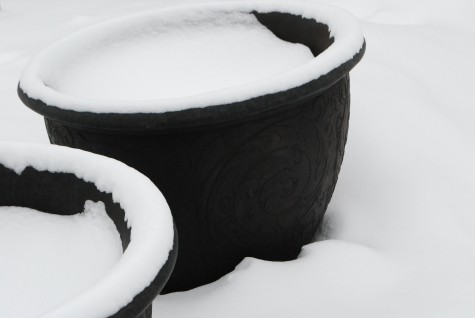 Perhaps the very best time to look at whether the design of a landscape is working is when it is reduced to its black and white bones. Every sculpture, pot, fence or other inanimate object has a shape that is unmistakable. The shape and size of this brown pot makes a far stronger statement than its surface decoration. When I look at pots for a specific spot, I consider the shape and proportion first, and its color or surface decoration second. The most gorgeous pot in the world will not look like it-placed in the wrong spot. I am getting a lot of visual help from the snow here. It blankets the ground, and every other horizontal surface. There is no grass, water, flowers, dog toys, bugs, leaves or birds to distract me. I can see the form, as it is all that is there to see. I suddenly realize why people photograph objects with a white background. To better see the object, yes? It may be that the ability to design has something to do with being able to see like this-in spite of all the extraneous noise. Winter is an incredibly quiet time in a garden, in more ways than one.
Perhaps the very best time to look at whether the design of a landscape is working is when it is reduced to its black and white bones. Every sculpture, pot, fence or other inanimate object has a shape that is unmistakable. The shape and size of this brown pot makes a far stronger statement than its surface decoration. When I look at pots for a specific spot, I consider the shape and proportion first, and its color or surface decoration second. The most gorgeous pot in the world will not look like it-placed in the wrong spot. I am getting a lot of visual help from the snow here. It blankets the ground, and every other horizontal surface. There is no grass, water, flowers, dog toys, bugs, leaves or birds to distract me. I can see the form, as it is all that is there to see. I suddenly realize why people photograph objects with a white background. To better see the object, yes? It may be that the ability to design has something to do with being able to see like this-in spite of all the extraneous noise. Winter is an incredibly quiet time in a garden, in more ways than one.
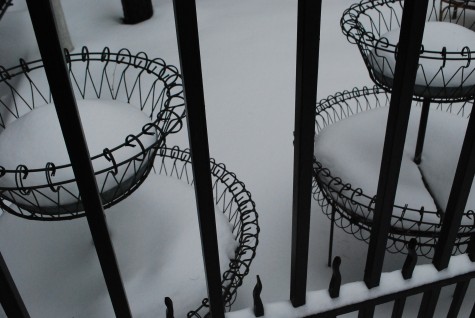 These wirework plant stands have details that could be lost, depending on how they are planted. The round shape will persist no matter what-making them a great choice where they can be viewed in the round. Against a flat wall seems like a less than optimal placement for this piece. I can clearly see the relationship of the round object to the straight wall of an iron fence. Celebrating what an object does best means looking long and hard at that object, and its relationship to a place. A fence creates an implacably strong shape and visual direction. Perhaps that is why serpentine walls and brush fences are so visually compelling. They are so unlike our intellectual idea of a fence. Trees planted close together so as to make a fence is an unexpected experience of a tree.
These wirework plant stands have details that could be lost, depending on how they are planted. The round shape will persist no matter what-making them a great choice where they can be viewed in the round. Against a flat wall seems like a less than optimal placement for this piece. I can clearly see the relationship of the round object to the straight wall of an iron fence. Celebrating what an object does best means looking long and hard at that object, and its relationship to a place. A fence creates an implacably strong shape and visual direction. Perhaps that is why serpentine walls and brush fences are so visually compelling. They are so unlike our intellectual idea of a fence. Trees planted close together so as to make a fence is an unexpected experience of a tree.
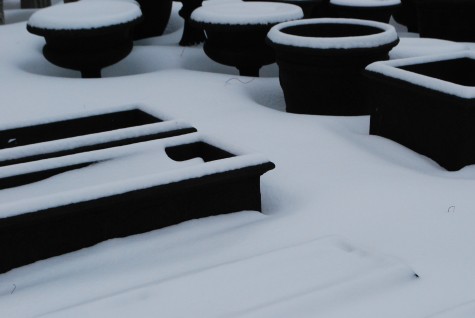 The placement, shape and mass of every object in a landscape-live or not creates visual relationships. Symmetrical relationships are calming, orderly and dignified. Asymmetrical relationships are dynamic, fluid, rhythmic. These concrete pots at the shop were placed to make efficient use of the space in which they are stored-not to look beautiful. The snow is so deep, the true shapes are obscured. The rectangle in the foreground is buried in snow. All I can really see here is the relationship of the black shapes to the white shapes. That relationship makes a description of depth. The mass of white in the foreground narrows to a ribbon of white that moves back in space diagonally to the grey- white in the far background. I see like this routinely. Seeing like this enables the ability to compose.
The placement, shape and mass of every object in a landscape-live or not creates visual relationships. Symmetrical relationships are calming, orderly and dignified. Asymmetrical relationships are dynamic, fluid, rhythmic. These concrete pots at the shop were placed to make efficient use of the space in which they are stored-not to look beautiful. The snow is so deep, the true shapes are obscured. The rectangle in the foreground is buried in snow. All I can really see here is the relationship of the black shapes to the white shapes. That relationship makes a description of depth. The mass of white in the foreground narrows to a ribbon of white that moves back in space diagonally to the grey- white in the far background. I see like this routinely. Seeing like this enables the ability to compose.
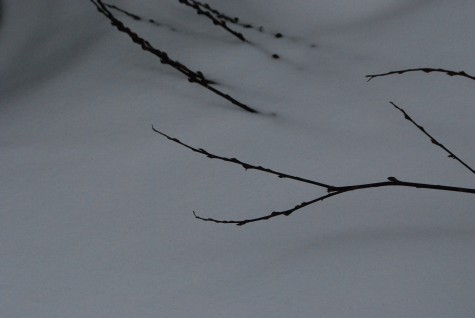 Every woody plant has an overall shape. Individual branches have their own shape, line and texture. Now might be the best time to look at trees and shrubs, should you be looking to add one. Should you want a dogwood worse than you need the size and shape of a dogwood, at least you know up front what the issues are; I am assuming you have covered the horticulktural bases. Deciduous shrubs that have been pruned into balls and squares tell all on a black and white day. You can decide if that style of pruning is what you want. My pollarded Palabin lilacs looked beautiful this morning. Another gardener might not warm up to that woman generated shape; natural, it is not.
Every woody plant has an overall shape. Individual branches have their own shape, line and texture. Now might be the best time to look at trees and shrubs, should you be looking to add one. Should you want a dogwood worse than you need the size and shape of a dogwood, at least you know up front what the issues are; I am assuming you have covered the horticulktural bases. Deciduous shrubs that have been pruned into balls and squares tell all on a black and white day. You can decide if that style of pruning is what you want. My pollarded Palabin lilacs looked beautiful this morning. Another gardener might not warm up to that woman generated shape; natural, it is not.
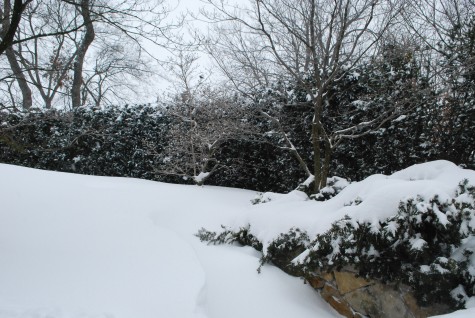
The stairs to the kitchen door are not only obliterated from view, they are buried under a drift that is amazingly deep. But the shape and the directional quality of the yews is apparent. This hedge has panic grass planted in front of it; I never see this view in the summer. I might some day want a different look, that does not obstruct the hedge, and its relationship to a magnolia and a kousa dogwood. I can see what the change would look like. More simple. Maybe visually stronger. Could it be that this part of my garden has so much competition for attention going on that it is not as good as it could be?
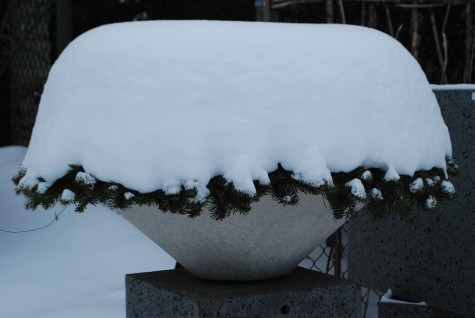 This contemporary limestone V-shaped bowl had a leftover wreath from the holidays on top. That wreath has proved to be an excellent snowcatcher. That snow gives me an excellent idea about what a single species summer planting might grow up to look like. It furthermore tells me that if I plant every plant vertically, rather than turning the rootballs of the outermost plants outward, I will end up with a stiffly vertical mature shape. Is this what I would want? It also tells me that a minimally trailing plant will best illustrate and preserve the view of the geometry of the pot.
This contemporary limestone V-shaped bowl had a leftover wreath from the holidays on top. That wreath has proved to be an excellent snowcatcher. That snow gives me an excellent idea about what a single species summer planting might grow up to look like. It furthermore tells me that if I plant every plant vertically, rather than turning the rootballs of the outermost plants outward, I will end up with a stiffly vertical mature shape. Is this what I would want? It also tells me that a minimally trailing plant will best illustrate and preserve the view of the geometry of the pot.
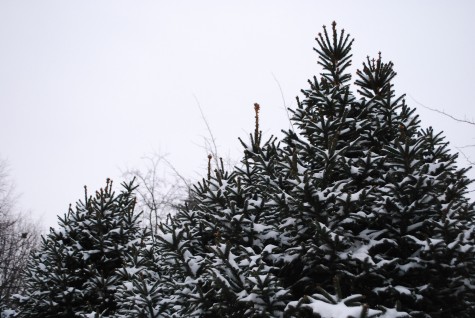 My picea mucrunulatum came with the house; they were planted on either side of my front walk. As I know them to be slow growing, and wider rather than tall, I moved them both to a spot on the drive where they had plenty of room to grow and mature without restriction. I never do one thing to them-except look at them. That was a good move. This black and white day reminds me what a beautifully complex texture they have.
My picea mucrunulatum came with the house; they were planted on either side of my front walk. As I know them to be slow growing, and wider rather than tall, I moved them both to a spot on the drive where they had plenty of room to grow and mature without restriction. I never do one thing to them-except look at them. That was a good move. This black and white day reminds me what a beautifully complex texture they have.
 Cardigan welsh corgis have very short legs. Milo’s might be 8 inches long. The snow depth is much more trouble for Milo than for me, but he is good natured about it. Corgi cum rabbit, he is these days. His only complaint is that I am reluctant to follow him out there. I finally had to get out there-before he completely disappeared. The overnight forecast? More snow.
Cardigan welsh corgis have very short legs. Milo’s might be 8 inches long. The snow depth is much more trouble for Milo than for me, but he is good natured about it. Corgi cum rabbit, he is these days. His only complaint is that I am reluctant to follow him out there. I finally had to get out there-before he completely disappeared. The overnight forecast? More snow.
Leave a Comment